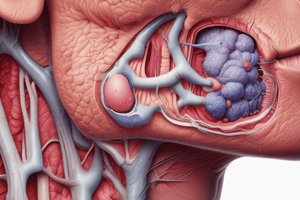Podcast
Questions and Answers
What are the functions of the nose/nasal cavity?
What are the functions of the nose/nasal cavity?
Helps partition the nasal cavity, increases surface area and turbulence, humidifies and warms air before it enters into the pharynx.
What is the main function of the pharynx?
What is the main function of the pharynx?
Transfers air
What are the structures associated with the larynx?
What are the structures associated with the larynx?
Paired cartilages: arytenoids, corniculate, cuneiform; Unpaired cartilages: thyroid, cricoid, epiglottis.
What is the function of the trachea?
What is the function of the trachea?
What happens to the primary bronchi during air conduction?
What happens to the primary bronchi during air conduction?
What are the pleural membranes?
What are the pleural membranes?
How are pressure gradients established in pulmonary ventilation?
How are pressure gradients established in pulmonary ventilation?
Flashcards are hidden until you start studying
Study Notes
Nose and Nasal Cavity
- Functions include partitioning the nasal cavity, increasing surface area and turbulence, and humidifying/warming air before reaching the pharynx.
- Composed of bone, hyaline cartilage, and dense irregular connective tissue.
- Structure includes one pair of lateral cartilages and two pairs of alar cartilages.
- Nasal cavity is an internal, oblong-shaped space extending from the choanae, divided by the nasal septum.
Pharynx
- Functions primarily in transferring air.
- Divided into three regions: nasopharynx, oropharynx, and laryngopharynx (superior to inferior order).
Larynx
- Contains paired cartilages: arytenoids, corniculate, cuneiform; and unpaired cartilages: thyroid, cricoid, epiglottis.
- True vocal cords produce sound located in the larynx.
- Glottis is the opening between true vocal cords; vestibular folds represent false vocal cords that protect true vocal cords.
- Vocal folds (true vocal cords) are responsible for sound production when air passes through them, creating vibrations.
Trachea
- Known as the windpipe, functions to conduct air.
- Structured with multiple C-shaped cartilage supports for rigidity.
- Posterior region abuts the esophagus, lacking cartilage.
- The carina marks the bifurcation of the trachea into left and right primary bronchi.
Bronchial Tree and Lungs
- Primary bronchi decrease in size, branching into secondary and tertiary bronchi, then into smaller bronchioles.
- Bronchioles are less than 1 mm in diameter, leading to terminal and respiratory bronchioles.
- Conduct air and allow for bronchoconstriction and bronchodilation through smooth muscle in walls.
- Respiratory bronchioles mark the beginning of the respiratory zone where gas exchange occurs with alveolar ducts and alveoli.
Respiratory Membrane
- Composed of capillary endothelium, simple squamous epithelium, shared basement membrane (type I pneumocytes), and surfactant layer (type II pneumocytes).
- Facilitates gas exchange in the lungs.
Pleural Membranes and Cavity
- Pleura is a serous membrane covering lung surfaces and the thoracic wall, formed by simple squamous epithelium.
- Visceral pleura lines the lungs, parietal pleura lines thoracic walls and diaphragm.
- Pleural cavity, situated between visceral and parietal layers, contains serous fluid that acts as a lubricant.
Pressure Gradients in Pulmonary Ventilation
- Outward pull of the chest and inward pull of the lungs create a "suction" effect that keeps lungs inflated.
- Intrapleural pressure is lower than intrapulmonary pressure, maintaining lung expansion; equal pressure results in lung deflation.
Studying That Suits You
Use AI to generate personalized quizzes and flashcards to suit your learning preferences.




